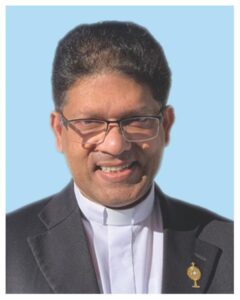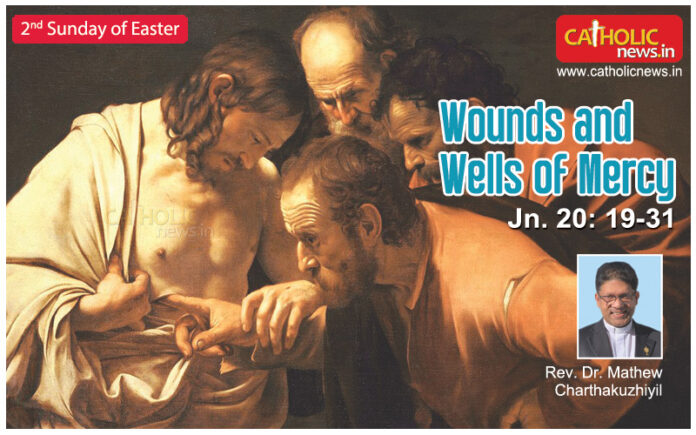
On the evening of that first Easter, the disciples gathered behind locked doors, their hearts heavy with fear and confusion after Jesus’ crucifixion. They were going through several emotions because of betrayal, loss, and the collapse of their hopes. But Jesus comes back into their lives again – not with overwhelming signs, but with a gentle, transformative greeting: “Peace be with you.” These words, quiet yet filled with divine power, brought healing, dispelled fear, and rekindled hope. They marked a new beginning – one rooted in mercy and reconciliation, uniting the disciples to their risen Lord and sending them out in mission.
The Gospel directs our attention to Jesus’ wounds – his pierced hands and side. These are not just marks of past suffering, but radiant signs of sacrificial love. The Resurrection does not erase them; it glorifies them, turning wounds into wells of grace. Through these wounds, Christ breathes peace upon his disciples and entrusts them with the ministry of forgiveness. He does not deny the reality of the cross but redeems it, revealing that suffering, united with divine love, becomes a fountain of life. These wounds stand forever as signs that love is stronger than death.
But St. Thomas was absent during the first appearance, he struggles with doubt – not because he lacks faith, but because he longs for his own encounter with the Risen Lord. His honesty mirrors our own yearning: not just to hear about resurrection, but to touch it. Jesus returns – not to rebuke Thomas, but to meet him with tender invitation: “Put your finger here… do not be unbelieving but believe.” In that moment, doubt becomes a doorway. Thomas responds not just with belief, but with the deepest confession in all the Gospels: “My Lord and my God.” Christ’s wounds, far from hiding glory, become the very means through which faith is born.
This Sunday, dedicated to Divine Mercy, draws us into this mystery more deeply. Saint Faustina Kowalska’s visions and the Church’s witness unite to proclaim that from Christ’s pierced heart flows an inexhaustible stream of compassion, forgiveness, and love. St. Augustine once wrote, “In his wounds we find refuge, for they laid bare the mercy of his heart.” These wounds do not vanish – they shine, so that we may find healing within them.
Each of us carries wounds – some visible, others buried deep within. We lock ourselves in our own “upper rooms” of fear, regret, or sorrow, uncertain whether healing is possible. Yet it is precisely into those closed spaces that Christ comes bringing his peace. The Resurrection does not erase our brokenness – it transfigures it, revealing that even our pain can be part of God’s redemptive work. Christ enters our most hidden places and breathes new life. To live Divine Mercy means allowing God’s love to transform us daily. But mercy is not a private gift – it must be shared. It takes form in the forgiveness we extend, in the compassion we show, and in the burdens we help others carry.
God’s mercy is larger than our sins and more enduring than our failures. The Church, like her crucified and risen Lord, keeps her doors open to all – sinners, seekers, doubters. In the Sacrament of Reconciliation, we meet the face of mercy. In the Eucharist, we are sustained by it. In every act of sincere repentance, we are restored. Christ longs to breathe his Spirit into our weakness, to speak peace into our restless hearts. May our wounds, like his, become places where grace overflows. May our lives reflect the mercy we have received and confess with joy and trust: “My Lord and my God.”
Rev. Dr. Mathew Charthakuzhiyil



